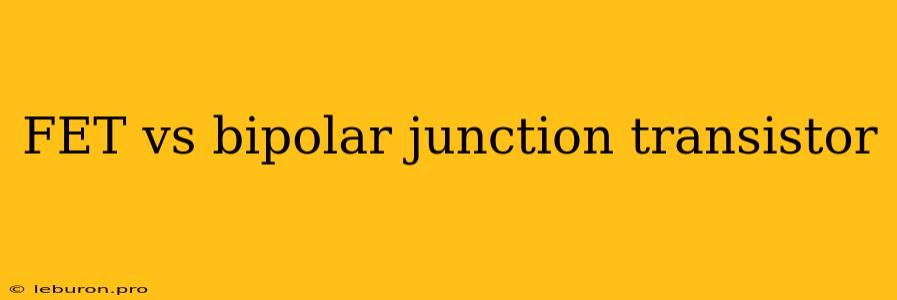The world of electronics is built upon the foundation of transistors, tiny semiconductors that act as the building blocks of amplifiers, oscillators, and countless other circuits. Among the various types, two stand out: the FET (Field-Effect Transistor) and the Bipolar Junction Transistor (BJT). Both play crucial roles in modern electronics, each with its own unique advantages and drawbacks. Understanding the key differences between FETs and BJTs is essential for choosing the right component for a specific application. This article delves into the core characteristics, operational principles, and applications of these essential components.
The Core of the Difference: How They Work
The fundamental distinction between FETs and BJTs lies in the way they control current flow. FETs utilize an electric field to control the flow of current, while BJTs rely on the injection of minority charge carriers. Let's explore each type in more detail.
The Field-Effect Transistor (FET)
FETs operate on the principle of controlling current through a channel by manipulating an electric field. The channel, typically made of a semiconductor material like silicon, acts as the path for current flow. A gate terminal, separated from the channel by an insulating layer, controls the channel's conductivity.
FETs can be further categorized into three main types:
-
Junction FETs (JFETs): These FETs use a PN junction to create the gate terminal. By applying a reverse bias voltage to the gate, the depletion region widens, reducing the channel width and thus controlling current flow.
-
Metal-Oxide-Semiconductor FETs (MOSFETs): MOSFETs are the most prevalent type of FETs and are commonly found in integrated circuits. They utilize a metal gate separated from the channel by a thin oxide layer. By applying a voltage to the gate, an electric field is created, attracting charge carriers to the channel, enhancing conductivity.
-
Insulated-Gate FETs (IGFETs): These FETs are similar to MOSFETs, but the gate insulator is not limited to oxide materials.
The Bipolar Junction Transistor (BJT)
BJTs are based on the principle of current amplification. They consist of two PN junctions, forming either an NPN or PNP structure. Current flows through the device by injecting minority charge carriers into the base region.
-
NPN Transistors: In an NPN BJT, a small current flowing into the base region controls a larger current flowing from the emitter to the collector.
-
PNP Transistors: In a PNP BJT, a small current flowing into the base region controls a larger current flowing from the emitter to the collector.
BJTs are known for their high current gain, meaning a small base current can control a much larger collector current. However, they also have a higher power consumption than FETs.
Comparing FETs and BJTs: Key Differences
The following table summarizes the key differences between FETs and BJTs:
| Feature | FET | BJT |
|---|---|---|
| Operating Principle | Electric Field Control | Current Injection |
| Input Impedance | High | Low |
| Current Gain | Low | High |
| Power Consumption | Low | High |
| Switching Speed | Fast | Slow |
| Noise | Low | High |
| Temperature Stability | Good | Poor |
| Applications | Analog circuits, digital circuits, power electronics | Audio amplifiers, switching circuits, RF amplifiers |
Advantages of FETs
-
High Input Impedance: FETs have a high input impedance, meaning they draw very little current from the input signal. This makes them ideal for applications where the signal source has a high impedance.
-
Low Power Consumption: FETs typically consume less power than BJTs, making them suitable for battery-powered devices and low-power circuits.
-
Fast Switching Speed: FETs can switch between on and off states very quickly, making them suitable for high-frequency applications.
-
Low Noise: FETs generate less noise than BJTs, making them preferable for sensitive circuits.
-
Good Temperature Stability: FETs tend to be more stable over a wide temperature range than BJTs.
Advantages of BJTs
-
High Current Gain: BJTs offer higher current gain than FETs, meaning a small base current can control a larger collector current. This is useful for applications where high power amplification is needed.
-
Widely Available: BJTs have been around longer than FETs and are generally more readily available and cost-effective.
-
Easy to Understand: The basic principles of BJT operation are relatively simple and intuitive to grasp.
Applications of FETs and BJTs
FETs and BJTs find their place in various applications, driven by their unique advantages.
FETs are commonly used in:
- Analog Circuits: Amplifiers, filters, oscillators, and other analog circuits.
- Digital Circuits: Logic gates, memory cells, and other digital circuits.
- Power Electronics: Switching regulators, inverters, and other power electronics applications.
BJTs are commonly used in:
- Audio Amplifiers: Class A, B, AB, and other types of audio amplifiers.
- Switching Circuits: Power supplies, relays, and other switching applications.
- RF Amplifiers: Radio frequency amplifiers for communication systems.
Conclusion
FETs and BJTs are both essential components in modern electronics, each with its strengths and weaknesses. FETs, with their high input impedance, low power consumption, and fast switching speeds, are well-suited for applications where signal fidelity and efficiency are paramount. BJTs, on the other hand, excel in applications requiring high current gain and power amplification. Understanding the fundamental differences between these two transistor types is crucial for making informed choices when designing electronic circuits. Whether you're building an audio amplifier, a digital logic circuit, or a power converter, choosing the right type of transistor will ensure optimal performance and efficiency.
